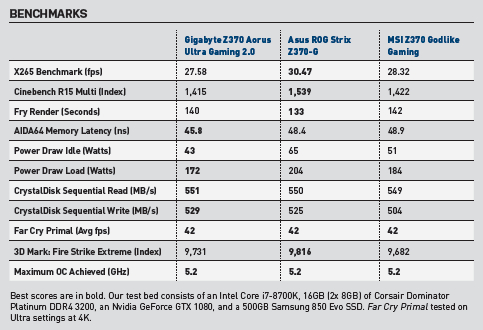Our Verdict
In the end, this looks good, performs well, and hits the price nail right on the head.
For
- Good temperatures
- Impressive power draw
- Good price
Against
- BIOS needs work
PC Gamer's got your back
Ahh, Coffee Lake, what a life you’ve had. Whether it was a response to Ryzen or not, there’s no denying that Intel produced some of the best gaming motherboards out of that architecture. The quad-cored Core i3-8100 and the hex-cored Core i5-8400, to name just two, are incredible value propositions that we adored. For anyone looking to build a cost effective PC, these are prime parts, perfect for a super-nippy office machine or better-geared gaming rig.
Price: $170
Chipset/Socket: Z370/LGA1151
Form Factor: ATX
Memory Support: 64GB DDR4 @ 4,000MT/s
M.2/U.2 Support: 2x M.2
SATA Support: 6x SATA 6Gb/s
Max PCIe Support: 3x PCIe 3.0 x16 (x16, x8x8, or x8x4x4)
Rear I/O: 5x USB 3.1 Type A, 1x USB 3.1 Type C, 2x USB 2.0, Gigabit Ethernet, 5.1 audio, optical out, PS/2 combi port
Couple that with the well-equipped Z370 chipset, and the generation as a whole is far from being dead in the water. But as we’ve seen time and time again, the effect your mobo of choice has on performance is often less than 5 percent, if that. When it comes to deciding exactly which mobo you want to pair with your processor kingpin, the decision process inevitably comes down to three factors: What form factor do you want, what connectivity do you need, and which manufacturer do you prefer?
Gigabyte’s Z370 Aorus Ultra Gaming 2.0 is a revision of one of its more popular mid-to-high-end line-ups, the Ultra Gaming. Packing a clean look, plenty of connectivity, and solid dependable performance with an affordable price tag, it’s a product that’s well placed to hold on to substantial market share, and is a perfect choice for anyone looking to build a mid-range Core i3 or i5 machine.
Compared to the basic Ultra Gaming, the 2.0 features an M.2 PCIe SSD heatsink as standard, and a new 11-phase power design, which helps reduce coil whine when overclocked or under heavy load. One downside of this shift, however, is that you do lose out on the integrated DVI-I support in the rear I/O. Which is a bit odd, as it’s replaced by nothing at all. That said, it’s a decent, well-rounded upgrade to the platform, especially if you’re looking at utilizing an unlocked K-series part.

Want a different form-factor, or just to check out the competition? Here's our guide to the best gaming motherboards.
Right then, let’s talk performance. What are we looking at here? The Gaming 2.0 is a bit of anomaly in our testing suite, especially when it comes to power draw. We’ve commented in the past about how Asus’s mobos typically have optimizations in the BIOS that both boost the V-Core and improve performance in Cinebench R15 and GeekBench. It ultimately leads to higher scores in those benchmarks (around 9 percent). However, on the flip side, the trade-offs usually extend to a CPU temperature increase of about six or seven degrees Celsius and, of course, a far higher power draw. The Ultra Gaming 2.0, on the other hand, scores lower in the benchmarks, thanks to its stock configuration, but you do gain those lower running temps, lower power draw, and an overall quieter rig, even without the grunt of Asus’s fan profile tech behind it.
As far as overclocking is concerned, we still couldn’t push our Core i7-8700K past 5.2GHz, but it did manage that fairly effortlessly, and the coil whine wasn’t overly noticeable. One thing we would love to see, however, is a far better BIOS than Gigabyte currently offers. It does the job, but the overall layout and access to information is limited at best, and it tends to look a little dated compared to that of the competition.
All that said, the Gigabyte Ultra Gaming 2.0 is a finely balanced motherboard, with enough guts and fun to support anyone looking at investing in a well-rounded Coffee Lake system. If you’re happy to tinker around with a slight overclock to your chip, you can easily match the performance of the Asus competition without much trouble. In the end, it looks good, performs well, and hits the price nail right on the head.
This article was originally published in Maximum PC's July issue. For more quality articles about all things PC hardware, you can subscribe to Maximum PC now.
In the end, this looks good, performs well, and hits the price nail right on the head.
After graduating from the University of Derby in 2014, Zak joined the PC Format and Maximum PC team as its resident staff writer. Specializing in PC building, and all forms of hardware and componentry, he soon worked his way up to editor-in-chief, leading the publication through the covid dark times. Since then, he’s dabbled in PR, working for Corsair for a while as its UK PR specialist, before returning to the fold as a tech journalist once again.
He now operates as a freelance tech editor, writing for all manner of publications, including PC Gamer, Maximum PC, Techradar, Gamesradar, PCGamesN, and Trusted Reviews as well. If there’s something happening in the tech industry it’s highly likely Zak has a strong opinion on it.



